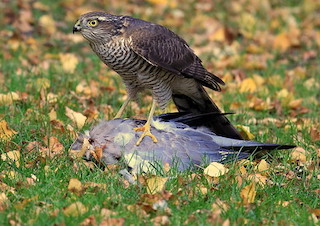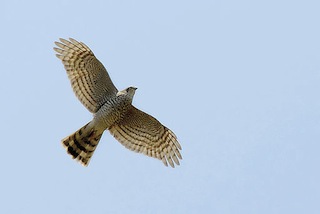 Although the Sparrowhawk breeds in woodland, it can be spotted hunting across many habitats.
Although the Sparrowhawk breeds in woodland, it can be spotted hunting across many habitats.
Photo: © Natural England/Andy Neale
Scientific name: Accipiter nisus
Other common names: Eurasian Sparrowhawk, Northern Sparrowhawk
Conservation status: UK Birds of Conservation Concern, Green; IUCN Red List, Least Concern
What to look for:
- Colouring and appearance: Males: blue-grey above and wings, barred orange-brown on underparts. Females and immature adults: brown above and wings, with brown bars on underparts. Both sexes have vivid orange/yellow irises and yellow legs.
- Size: Length 28 to 38 cm, wingspan 55 to 70 cm. Females are larger than males.
- Where: Across most of the UK, apart from the far north-west.
 The Sparrowhawk is one of the smaller birds of prey, adapted for hunting small birds in woodland, but also found in other habitats, including urban areas and gardens. The larger females prey on birds as large as pigeons, though they mainly keep to birds no larger than thrushes.
The Sparrowhawk is one of the smaller birds of prey, adapted for hunting small birds in woodland, but also found in other habitats, including urban areas and gardens. The larger females prey on birds as large as pigeons, though they mainly keep to birds no larger than thrushes.
They are known to use gardens, where small birds are often attracted, as a hunting ground. Long-term scientific studies show Sparrowhawks have very little, if any, impact on songbird numbers, however. Indeed, when Sparrowhawk numbers plummeted in the 1960s due to the use of pesticides, songbird numbers remained the same.
Although they can be spotted in a range of habitats, Sparrowhawks need woodland for breeding. The nest – a bark-lined twig platform – is built close to a tree trunk and as hidden from sight as possible. Up to six eggs are laid during May at intervals of two-days. Hatching is similarly staggered. The female cares for the young while the male hunts for food for his mate and the chicks.
 Did you know…?
Did you know…?
…Female Sparrowhawks are as much as 25% bigger than the males.
…The staggered hatching of the young helps cope with changes in food supply. When there is plenty of prey, all the young will survive, but if prey runs short, the younger, weaker chick(s) will die, meaning there is more food for the older siblings.
More information and references:
Svensson, L., Mullarney, K., Zetterstrom, D.,1986. Collins Bird Guide, second edition (translated by Christie, D., Svensson, L.). HarperCollins, London.
Published: May 2015
Author: Amanda Scott
Photos: Upper – © Natural England/Andy Neale; lower – Christian Knoch (Self-photographed) [CC BY-SA 2.0]
